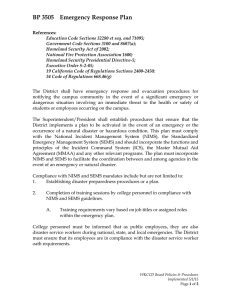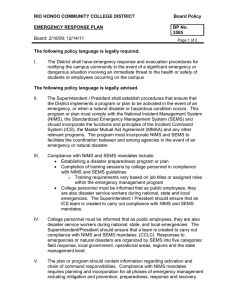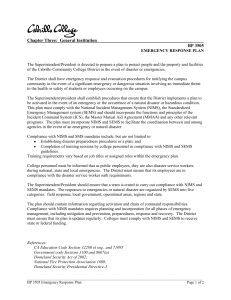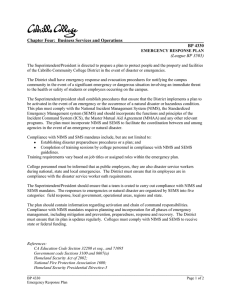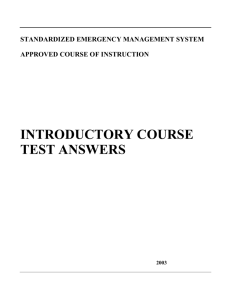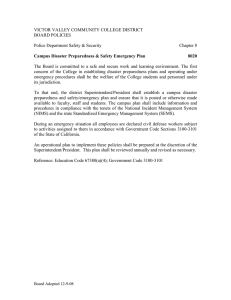RIO HONDO COMMUNITY COLLEGE DISTRICT ... EMERGENCY RESPONSE PLAN AP No. 3505
advertisement
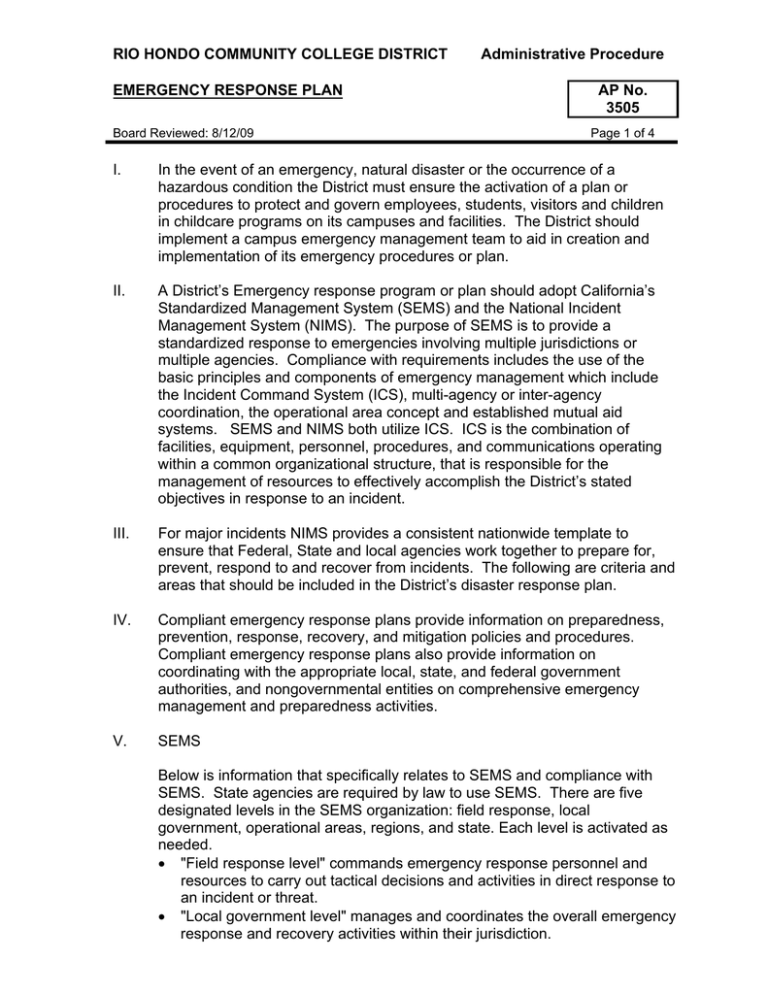
RIO HONDO COMMUNITY COLLEGE DISTRICT EMERGENCY RESPONSE PLAN Board Reviewed: 8/12/09 Administrative Procedure AP No. 3505 Page 1 of 4 I. In the event of an emergency, natural disaster or the occurrence of a hazardous condition the District must ensure the activation of a plan or procedures to protect and govern employees, students, visitors and children in childcare programs on its campuses and facilities. The District should implement a campus emergency management team to aid in creation and implementation of its emergency procedures or plan. II. A District’s Emergency response program or plan should adopt California’s Standardized Management System (SEMS) and the National Incident Management System (NIMS). The purpose of SEMS is to provide a standardized response to emergencies involving multiple jurisdictions or multiple agencies. Compliance with requirements includes the use of the basic principles and components of emergency management which include the Incident Command System (ICS), multi-agency or inter-agency coordination, the operational area concept and established mutual aid systems. SEMS and NIMS both utilize ICS. ICS is the combination of facilities, equipment, personnel, procedures, and communications operating within a common organizational structure, that is responsible for the management of resources to effectively accomplish the District’s stated objectives in response to an incident. III. For major incidents NIMS provides a consistent nationwide template to ensure that Federal, State and local agencies work together to prepare for, prevent, respond to and recover from incidents. The following are criteria and areas that should be included in the District’s disaster response plan. IV. Compliant emergency response plans provide information on preparedness, prevention, response, recovery, and mitigation policies and procedures. Compliant emergency response plans also provide information on coordinating with the appropriate local, state, and federal government authorities, and nongovernmental entities on comprehensive emergency management and preparedness activities. V. SEMS Below is information that specifically relates to SEMS and compliance with SEMS. State agencies are required by law to use SEMS. There are five designated levels in the SEMS organization: field response, local government, operational areas, regions, and state. Each level is activated as needed. • "Field response level" commands emergency response personnel and resources to carry out tactical decisions and activities in direct response to an incident or threat. • "Local government level" manages and coordinates the overall emergency response and recovery activities within their jurisdiction. RIO HONDO COMMUNITY COLLEGE DISTRICT EMERGENCY RESPONSE PLAN Board Reviewed: 8/12/09 • • • Administrative Procedure AP No. 3505 Page 2 of 4 "Operational area level" manages and/or coordinates information, resources, and priorities among local governments within the operational area and serves as the coordination and communication link between the local government level and the regional level. "Regional level" manages and coordinates information and resources among operational areas within the mutual aid region designated pursuant to Government Code section 8600 and between the operational areas and the state level. This level along with the state level coordinates overall state agency support for emergency response activities. "State level" manages state resources in response to the emergency needs of the other levels, manages and coordinates mutual aid among the mutual aid regions and between the regional level and state level, and serves as the coordination and communication link with the federal disaster response system. The local government level, operational area level, regional level and the state level shall include the following functions: • Management • Operations • Planning/intelligence • Logistics and • Finance/Administration VI. Training The District shall determine the appropriate level(s) of SEMS training for each of its employees. This determination is dependent upon the employee’s potential assignment during an emergency response situation. The District should ensure that its emergency response personnel can demonstrate and maintain, the minimum SEMS performance objectives, at the appropriate level, is required by the District's training programs. VII. Compliance with SEMS To be compliant with SEMS requirements the District must include the five essential SEMS functions in its emergency response plan. To be in compliance with SEMS, emergency response plans must at minimum, address the following functions: • Management • Operations • Logistics • Planning/Intelligence and • Finance/Administration RIO HONDO COMMUNITY COLLEGE DISTRICT Administrative Procedure EMERGENCY RESPONSE PLAN Board Reviewed: 8/12/09 AP No. 3505 Page 3 of 4 Local government must use SEMS in order to be eligible for state funding for response-related personnel costs which occur in response to an incident. The District shall use SEMS to coordinate multiple jurisdiction or multiple agency emergency and disaster operations. In the event that a local emergency occurs and the Governor declares a state of emergency, if the District responds to said emergency, the District shall complete and transmit an after action report to OES within 90 days of the close of the incident period. The after action report shall at a minimum include a review of the response actions taken, the application of SEMS, the identified training needs, suggested modifications to SEMS, necessary modifications to the SEMS plans and procedures and an up to date recall of the recovery actions. VIII. NIMS The District must also be in compliance with the federal requirements for emergency preparedness, or NIMS. The five components of NIMS are: • Command and Management, including ICS; • Preparedness; • Resource Management; • Communications and Information Management; • Supporting Technologies; and • NIMS Management and Maintenance. IX. Compliance with NIMS To comply with NIMS requirements, the District must ensure that its employees are receive the appropriate NIMS training. NIMS compliance is measured by a performance-based “metrics” system. In addition to the training requirements, the District must also comply with state and federal preparedness laws for public institutions. The District can work with the Disaster Resistant California Community Colleges (DRCCC) program to ensure it’s in compliance with state and federal requirements. X. Definitions: The following definitions may be relevant to the implementation of an emergency response plan: RIO HONDO COMMUNITY COLLEGE DISTRICT EMERGENCY RESPONSE PLAN Board Reviewed: 8/12/09 Administrative Procedure AP No. 3505 Page 4 of 4 Emergency - means a condition of disaster or of extreme peril to the safety of persons and property caused by such conditions as air pollution, fire, flood, hazardous material incident, storm, epidemic, riot, drought, sudden and severe energy shortage, plant or animal infestations or disease, the Governor's warning of an earthquake or volcanic prediction, or an earthquake or other conditions, other than conditions resulting from a labor controversy. Incident is defined as an occurrence or event, either human-caused or by natural phenomena, that requires action by emergency response personnel to prevent or minimize loss of life or damage to property and/or natural resources. Incident Command System (ICS) means the nationally used standardized on-scene emergency management concept specifically designed to allow its user(s) to adopt an integrated organizational structure equal to the complexity and demands of single or multiple incidents without being hindered by jurisdictional boundaries. ICS is the combination of facilities, equipment, personnel, procedures, and communications operating within a common organizational structure, with responsibility for the management of resources to effectively accomplish stated objectives pertinent to an incident. XI. References: Education Code Sections 32280 et. seq. and 71095.; Government Code Sections 3100 et seq., 8600, 8605, 8558, 8559 and 8607(a); Homeland Security Act of 2002; National Fire Protection Association 1600; Homeland Security Presidential Directive-5; Executive Order S-2-05; 19 California Code of Regulations (CCR) Sections 2400-2450
